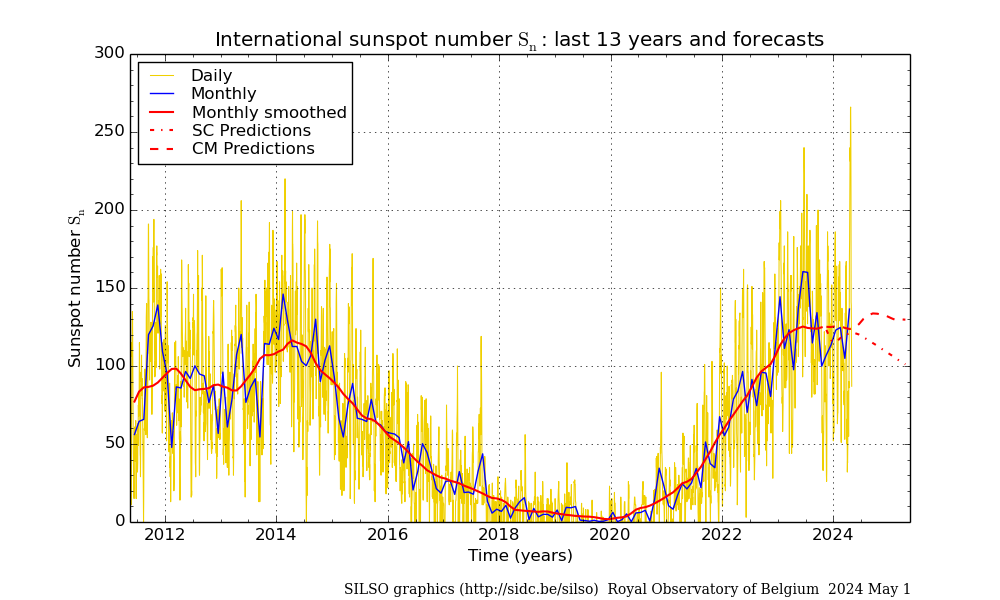Our preferred source for sunspot activity is SILSO, a department of the Royal Observatory of Belgium. Here's their most recent presentation of the number of sunspots:

Sunspots themselves aren't that important, well they're important but for our non-astrophysicist purposes they are important for what they reveal about how energetic that big orb in the sky is.
Further to that, our preferred source for discussion on Coronal Mass Ejections and solar flares is SpaceWeather.com.
And the headline story, from Popular Mechanics, September 19:
The mega-solar storm in May 2024 may mark the beginning of a new normal in the coming decades.
Here’s what you’ll learn when you read this story:
- The intensity of the Sun’s activity ebbs and flows across years, but also across decades—a behavior that scientists haven’t quite figured out yet.
- At the turn of the 21st century, astrophysicists theorized that the Sun was headed toward a deep solar minimum, but a new study says that the Sun’s activity actually reversed course around 2008.
- This means that, for the next few decades, solar storms will likely be a more common occurrence.
The swirling ball of hydrogen and helium gas known as the Sun is a fiery cauldron responsible for all life on Earth, but it can also be a source of serious danger. Seeing as it figures so prominently in our lives, scientists have been keeping track of the Sun’s activities since the dawn of the modern telescope (Galileo started taking notice of sunspots as early as the 17th century). Over time, scientists have learned about the Sun’s myriad cycles, including both its 11-year solar cycle and its 22-year Hale cycle, which is named after American astrophysicist George Ellery Hale.
While these cycles give us reliable estimates for when to expect increased solar activity and sunspots, the Sun follows even longer phases of high and low activity that can sometimes stretch across decades. For example, between 1645 to 1715 the Sun experienced a pronounced period of low activity known as the Maunder Minimum, and the same is true between the years 1790 and 1830 (a.k.a. the Dalton Minimum).
At the dawn of the 21st century, astrophysicists thought the Sun was entering a new “deep solar minimum,” as activity had been steadily decreasing since the 1980s. But a new NASA study published in The Astrophysical Journal Letters claims that solar activity actually reversed course from this expected trajectory around 2008, leading to a noticeable increase in solar storms, flares, and coronal mass ejections.
“All signs were pointing to the Sun going into a prolonged phase of low activity,” Jamie Jasinski, lead author of the new study from NASA’s Jet Propulsion Laboratory, said in a press statement. “So it was a surprise to see that trend reversed. The Sun is slowly waking up.”
NASA scientists came to this conclusion by poring over data from two primary heliophysics missions—the Advanced Composition Explorer (ACE) and the Wind mission. Both launched in the 1990s, these two spacecraft took detailed notes on the flow of plasma and energetic particles from the Sun toward Earth.
Although scientists have a pretty good handle on the timing of the solar and Hale cycles—the last solar maximum occurred in October of 2025, and Cycle 25 is still in its maximum—predictions regarding its intensity didn’t quite pan out. As Live Science notes, the Sun has reached its highest number of sunspots in two decades and burped out a record number of X-class flares, which are the most powerful category of solar flares....
....MUCH MORE
Here, with additional commentary is noted solar physicist Bob Seeger:
She packed up her bags and she took off down the road
She left me here stranded with the bills she owed
She gave me a false address
Took off with my American Express
Sunspot baby
She sure had me way outguessed...